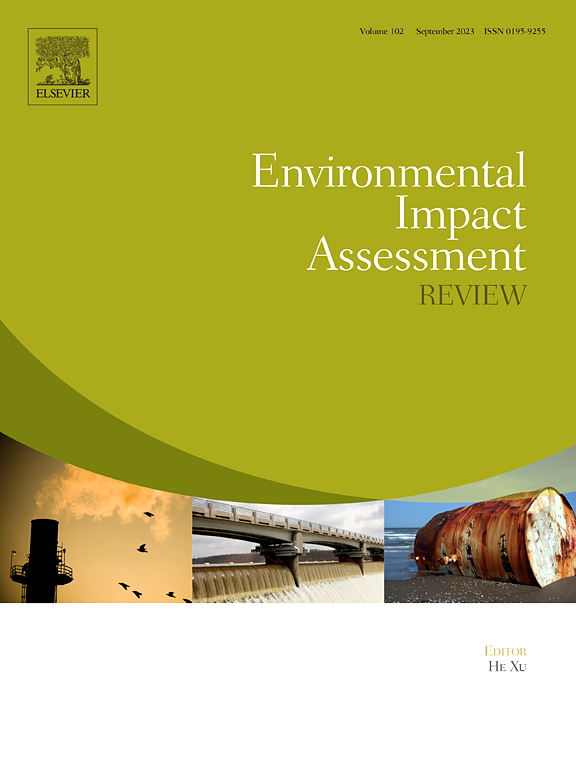农民租赁更多农地如何影响农药投入?来自中国农民的微观证据
IF 9.8
1区 社会学
Q1 ENVIRONMENTAL STUDIES
引用次数: 0
摘要
在确保农业生产力的同时,农药使用的加剧导致包括中国在内的许多国家的环境绩效不佳。最近中国农民中土地租赁活动的增加提出了一些关键问题,包括它们对农药使用的潜在影响以及所涉及的潜在机制。本研究建立了一个基于农业生产损失控制和利润最大化相关函数的最优农药投入均衡理论模型。结合劳动力转移不完全性理论、边做边学理论和诱导技术变革理论,分析了土地出让对这一均衡的影响。实证分析利用了2020年至2022年中国土地经济调查(CLES)的微观数据。结果表明:1)在1%的显著水平上,土地租赁越多的农户农药投入量显著减少;2)异质性分析表明:a)有土地再配置意愿的农户在租赁土地后显著减少农药投入量,其他农户减少农药投入量,但不显著;b)生长期经常从事农业生产的农民在租赁土地后显著减少农药投入量,而其他农民则没有减少农药投入量。c)无论近年来是否遭受过农业灾害,农民在租赁土地后明显减少了农药投入量,但未受灾害影响的农民在减少农药使用方面表现更好。d)土地租赁条款明确的农户显著减少农药投入量,而条款不明确的农户没有减少农药投入量。(3)机制分析表明,农民在租赁更多土地后,通过三种途径减少农药投入量:a)培训中的激励一致性得到改善,农业培训产生的学习效应提高了农民农药投入量的能力建设。b)通过社会化的农药喷洒服务,确保更高的农药喷洒精度和标准。c)通过多样化作物种植减少有害生物的压力。这些发现强调了土地租赁在促进可持续农业实践方面的潜力,并为减少农药使用同时加强环境管理提供了宝贵的政策见解。本文章由计算机程序翻译,如有差异,请以英文原文为准。
How does farmers lease more agricultural land affect pesticide inputs? Microscopic evidence from Chinese farmers
The intensification of pesticide use, while ensuring agricultural productivity, has led to suboptimal environmental performance in numerous countries, including China. Recent increases in land leasing activities among Chinese farmers raise critical questions regarding their potential impact on pesticide usage and the underlying mechanisms involved. This study develops a theoretical model of optimal pesticide input equilibrium, informed by functions related to agricultural production loss control and profit maximization. By integrating theories concerning labor transfer incompleteness, learning-by-doing, and induced technological change, this research analyzes the effects of land leasing on this equilibrium. Empirical analysis utilizes micro-level data from the China Land Economic Survey (CLES) conducted between 2020 and 2022. The main findings are as follows: 1) Farmers who lease more land significantly reduce the amount of their pesticide inputs at the 1 % significance level. 2) Heterogeneity analyses show that: a) Farmers willing to reallocate land significantly reduced the amount of pesticide inputs after leasing land, while other farmers reduced it but not significantly. b) Farmers who are often involved in agricultural production during the growth period significantly reduced the amount of pesticide inputs after leasing land, while others did not reduce it. c) Regardless of whether they have suffered agricultural disasters in recent years, farmers significantly reduced the amount of pesticide inputs after leasing land, but farmers not affected by disasters performed better in reducing pesticide use. d) Households with clear land lease terms significantly reduced the amount of pesticide inputs, while those with unclear terms did not reduce it. 3) Mechanism analyses show that after leasing more land, farmers reduce the amount of pesticide inputs through three pathways: a) The incentive alignment in the training has been improved, and the resulting learning effect from agricultural training improves their capacity building of pesticide inputs. b) By ensuring higher accuracy and standards in pesticide spraying through socialized pesticide spraying services. c) By reducing pest pressure via diversified crop cultivation. These findings underscore the potential for land leasing to foster sustainable agricultural practices and provide valuable policy insights aimed at mitigating pesticide use while enhancing environmental management.
求助全文
通过发布文献求助,成功后即可免费获取论文全文。
去求助
来源期刊

Environmental Impact Assessment Review
ENVIRONMENTAL STUDIES-
CiteScore
12.60
自引率
10.10%
发文量
200
审稿时长
33 days
期刊介绍:
Environmental Impact Assessment Review is an interdisciplinary journal that serves a global audience of practitioners, policymakers, and academics involved in assessing the environmental impact of policies, projects, processes, and products. The journal focuses on innovative theory and practice in environmental impact assessment (EIA). Papers are expected to present innovative ideas, be topical, and coherent. The journal emphasizes concepts, methods, techniques, approaches, and systems related to EIA theory and practice.
 求助内容:
求助内容: 应助结果提醒方式:
应助结果提醒方式:


